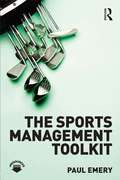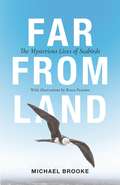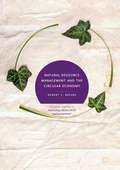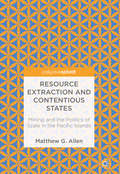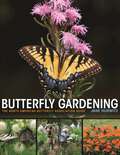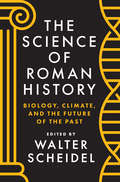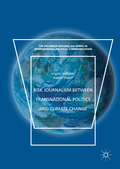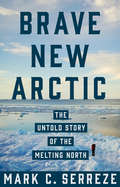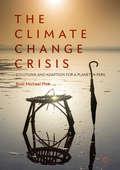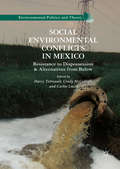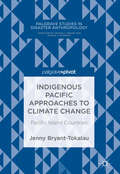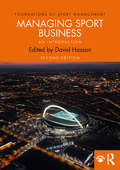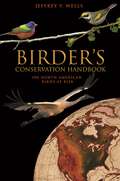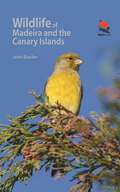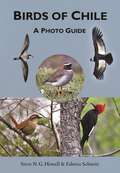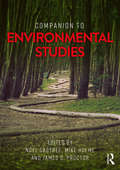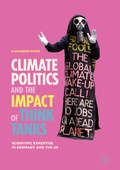- Table View
- List View
The Sports Management Toolkit (PDF)
by Paul EmeryThe Sports Management Toolkit is a practical guide to the most important management tools and techniques available to those working in the sport and leisure industries. Designed to bridge the gap between the classroom and the workplace, it includes ten free-standing chapters, each of which provides a detailed introduction to best practice in one of the core sports management disciplines. Written in a clear and straightforward style, and free of management jargon, the book covers all the key functional areas of contemporary sports management, including: marketing performance management risk management human resource management project management finance. Each chapter includes a detailed, step-by-step description of the key tools and techniques and their application; a ‘real world’ case study to demonstrate the technique in action, plus an extensive guide to further resources and a series of self-test questions. The final chapter offers an extended, integrated case-study, demonstrating how all the key management techniques are combined within the everyday operation of a successful sport or leisure organization. This book is essential reading for all students of sport and leisure management, and for all managers looking to improve their professional practice.
Far from Land: The Mysterious Lives of Seabirds
by Michael Brooke Bruce PearsonThe lives and activities of seabirds as you’ve never seen them beforeSeabirds evoke the spirit of the earth's wildest places. They spend large portions of their lives at sea, often far from land, and nest on beautiful and remote islands that humans rarely visit. Thanks to the development of increasingly sophisticated and miniaturized devices that can track their every movement and behavior, it is now possible to observe the mysterious lives of these remarkable creatures as never before. This beautifully illustrated book takes you on a breathtaking journey around the globe to reveal where these birds actually go when they roam the sea, the tactics they employ to traverse vast tracts of ocean, the strategies they use to evade threats, and more.Michael Brooke has visited every corner of the world in his lifelong pursuit of seabirds. Here, he draws on his own experiences and insights as well as the latest cutting-edge science to shed light on the elusive seafaring lives of albatrosses, frigatebirds, cormorants, and other ocean wanderers. Where do puffins go in the winter? How deep do penguins dive? From how far away can an albatross spot a fishing vessel worth following for its next meal? Brooke addresses these and other questions in this delightful book. Along the way, he reveals that seabirds are not the aimless wind-tossed creatures they may appear to be and explains the observational innovations that are driving this exciting area of research.Featuring illustrations by renowned artist Bruce Pearson and packed with intriguing facts, Far from Land provides an extraordinary up-close look at the activities of seabirds.
Far from Land: The Mysterious Lives of Seabirds
by Michael Brooke Bruce PearsonThe lives and activities of seabirds as you’ve never seen them beforeSeabirds evoke the spirit of the earth's wildest places. They spend large portions of their lives at sea, often far from land, and nest on beautiful and remote islands that humans rarely visit. Thanks to the development of increasingly sophisticated and miniaturized devices that can track their every movement and behavior, it is now possible to observe the mysterious lives of these remarkable creatures as never before. This beautifully illustrated book takes you on a breathtaking journey around the globe to reveal where these birds actually go when they roam the sea, the tactics they employ to traverse vast tracts of ocean, the strategies they use to evade threats, and more.Michael Brooke has visited every corner of the world in his lifelong pursuit of seabirds. Here, he draws on his own experiences and insights as well as the latest cutting-edge science to shed light on the elusive seafaring lives of albatrosses, frigatebirds, cormorants, and other ocean wanderers. Where do puffins go in the winter? How deep do penguins dive? From how far away can an albatross spot a fishing vessel worth following for its next meal? Brooke addresses these and other questions in this delightful book. Along the way, he reveals that seabirds are not the aimless wind-tossed creatures they may appear to be and explains the observational innovations that are driving this exciting area of research.Featuring illustrations by renowned artist Bruce Pearson and packed with intriguing facts, Far from Land provides an extraordinary up-close look at the activities of seabirds.
Natural Resource Management and the Circular Economy (Palgrave Studies In Natural Resource Management Ser.)
by Robert C. BrearsThis book provides insight into how governments are using a variety of innovative fiscal and non-fiscal instruments to develop circular economies with significant economic and environmental benefits. It emphasises the urgent need for these circular economies and to move away from our current, linear model that has led to environmental degradation, volatility of resource prices and supply risks from uneven distribution of natural resources.Natural Resource Management and the Circular Economy illustrates how governments have promoted the development of an economy that can provide substantial net material savings; mitigate price volatility and supply risks; and improve ecosystem health and long-term resilience of the economy. Through a series of case studies, it details the various innovative policy instruments which can be utilised, including regulations; market-based instruments; incentives; research and innovation support; information exchanges; and support for voluntary approaches. The book also proposes a series of best practices for different countries, both developed and developing, who are implementing their circular economy.
Natural Resource Management and the Circular Economy
by Robert C. BrearsThis book provides insight into how governments are using a variety of innovative fiscal and non-fiscal instruments to develop circular economies with significant economic and environmental benefits. It emphasises the urgent need for these circular economies and to move away from our current, linear model that has led to environmental degradation, volatility of resource prices and supply risks from uneven distribution of natural resources.Natural Resource Management and the Circular Economy illustrates how governments have promoted the development of an economy that can provide substantial net material savings; mitigate price volatility and supply risks; and improve ecosystem health and long-term resilience of the economy. Through a series of case studies, it details the various innovative policy instruments which can be utilised, including regulations; market-based instruments; incentives; research and innovation support; information exchanges; and support for voluntary approaches. The book also proposes a series of best practices for different countries, both developed and developing, who are implementing their circular economy.
Resource Extraction and Contentious States: Mining And The Politics Of Scale In The Pacific Islands
by Matthew G. AllenMining And The Politics Of Scale In The Pacific Islands
Butterfly Gardening: The North American Butterfly Association Guide
by Jane HurwitzAn indispensable and lavishly illustrated guide to creating a garden that attracts and sustains butterfliesButterfly gardening creates habitats that support butterflies, connecting us with some of the most beautiful creatures in the natural world and bringing new levels of excitement and joy to gardening. In this engaging and accessible guide, lavishly illustrated with more than two hundred color photographs and maps, accomplished butterfly gardener Jane Hurwitz presents essential information on how to choose and cultivate plants that will attract a range of butterflies to your garden and help sustain all the stages of their life cycles. An indispensable resource for aspiring and experienced butterfly gardeners alike, Butterfly Gardening is the most gardener-friendly source on the subject, covering all the practical details needed to create a vibrant garden habitat that fosters butterflies. It tells you which plants support which butterflies, depending on where you live; it describes what different butterflies require in the garden over the course of their lives; and it shows you how to become a butterfly watcher as well as a butterfly gardener.While predominantly recommending regionally native plants, the book includes information on non-native plants. It also features informative interviews with experienced butterfly gardeners from across the United States. These gardeners share a wealth of information on plants and practices to draw butterflies to all kinds of gardens--from small suburban gardens to community plots and larger expanses.Whether you are a gardener who wants to see more butterflies in your garden, a butterfly enthusiast who wants to bring that passion to the garden, or someone who simply wants to make their garden or yard friendlier to Monarchs or other butterflies, this is a must-have guide.An essential guide for aspiring and experienced butterfly gardenersEncourages readers to rethink gardening choices to support butterflies and other pollinators in their gardens and communitiesIntroduces gardeners to butterfly watchingIncludes regional lists of plant species that are time-proven to help sustain butterflies and their caterpillarsFeatures informative interviews with expert butterfly gardeners from across the United States
The Science of Roman History: Biology, Climate, and the Future of the Past
by Walter ScheidelHow the latest cutting-edge science offers a fuller picture of life in Rome and antiquityThis groundbreaking book provides the first comprehensive look at how the latest advances in the sciences are transforming our understanding of ancient Roman history. Walter Scheidel brings together leading historians, anthropologists, and geneticists at the cutting edge of their fields, who explore novel types of evidence that enable us to reconstruct the realities of life in the Roman world.Contributors discuss climate change and its impact on Roman history, and then cover botanical and animal remains, which cast new light on agricultural and dietary practices. They exploit the rich record of human skeletal material--both bones and teeth—which forms a bio-archive that has preserved vital information about health, nutritional status, diet, disease, working conditions, and migration. Complementing this discussion is an in-depth analysis of trends in human body height, a marker of general well-being. This book also assesses the contribution of genetics to our understanding of the past, demonstrating how ancient DNA is used to track infectious diseases, migration, and the spread of livestock and crops, while the DNA of modern populations helps us reconstruct ancient migrations, especially colonization.Opening a path toward a genuine biohistory of Rome and the wider ancient world, The Science of RomanHistory offers an accessible introduction to the scientific methods being used in this exciting new area of research, as well as an up-to-date survey of recent findings and a tantalizing glimpse of what the future holds.
The Science of Roman History: Biology, Climate, and the Future of the Past
by Walter ScheidelHow the latest cutting-edge science offers a fuller picture of life in Rome and antiquityThis groundbreaking book provides the first comprehensive look at how the latest advances in the sciences are transforming our understanding of ancient Roman history. Walter Scheidel brings together leading historians, anthropologists, and geneticists at the cutting edge of their fields, who explore novel types of evidence that enable us to reconstruct the realities of life in the Roman world.Contributors discuss climate change and its impact on Roman history, and then cover botanical and animal remains, which cast new light on agricultural and dietary practices. They exploit the rich record of human skeletal material--both bones and teeth—which forms a bio-archive that has preserved vital information about health, nutritional status, diet, disease, working conditions, and migration. Complementing this discussion is an in-depth analysis of trends in human body height, a marker of general well-being. This book also assesses the contribution of genetics to our understanding of the past, demonstrating how ancient DNA is used to track infectious diseases, migration, and the spread of livestock and crops, while the DNA of modern populations helps us reconstruct ancient migrations, especially colonization.Opening a path toward a genuine biohistory of Rome and the wider ancient world, The Science of RomanHistory offers an accessible introduction to the scientific methods being used in this exciting new area of research, as well as an up-to-date survey of recent findings and a tantalizing glimpse of what the future holds.
Risk Journalism between Transnational Politics and Climate Change (The\palgrave Macmillan Series In International Political Communication Ser.)
by Ingrid Volkmer Kasim SharifRisk Journalism between Transnational Politics and Climate Change
Brave New Arctic: The Untold Story of the Melting North (Science Essentials)
by Mark C. SerrezeAn insider account of how researchers unraveled the mystery of the thawing ArcticIn the 1990s, researchers in the Arctic noticed that floating summer sea ice had begun receding. This was accompanied by shifts in ocean circulation and unexpected changes in weather patterns throughout the world. The Arctic's perennially frozen ground, known as permafrost, was warming, and treeless tundra was being overtaken by shrubs. What was going on? Brave New Arctic is Mark Serreze's riveting firsthand account of how scientists from around the globe came together to find answers.In a sweeping tale of discovery spanning three decades, Serreze describes how puzzlement turned to concern and astonishment as researchers came to understand that the Arctic of old was quickly disappearing--with potentially devastating implications for the entire planet. Serreze is a world-renowned Arctic geographer and climatologist who has conducted fieldwork on ice caps, glaciers, sea ice, and tundra in the Canadian and Alaskan Arctic. In this must-read book, he blends invaluable insights from his own career with those of other pioneering scientists who, together, ushered in an exciting new age of Arctic exploration. Along the way, he accessibly describes the cutting-edge science that led to the alarming conclusion that the Arctic is rapidly thawing due to climate change, that humans are to blame, and that the global consequences are immense.A gripping scientific adventure story, Brave New Arctic shows how the Arctic's extraordinary transformation serves as a harbinger of things to come if we fail to meet the challenge posed by a warming Earth.
Brave New Arctic: The Untold Story of the Melting North (Science Essentials)
by Mark C. SerrezeAn insider account of how researchers unraveled the mystery of the thawing ArcticIn the 1990s, researchers in the Arctic noticed that floating summer sea ice had begun receding. This was accompanied by shifts in ocean circulation and unexpected changes in weather patterns throughout the world. The Arctic's perennially frozen ground, known as permafrost, was warming, and treeless tundra was being overtaken by shrubs. What was going on? Brave New Arctic is Mark Serreze's riveting firsthand account of how scientists from around the globe came together to find answers.In a sweeping tale of discovery spanning three decades, Serreze describes how puzzlement turned to concern and astonishment as researchers came to understand that the Arctic of old was quickly disappearing--with potentially devastating implications for the entire planet. Serreze is a world-renowned Arctic geographer and climatologist who has conducted fieldwork on ice caps, glaciers, sea ice, and tundra in the Canadian and Alaskan Arctic. In this must-read book, he blends invaluable insights from his own career with those of other pioneering scientists who, together, ushered in an exciting new age of Arctic exploration. Along the way, he accessibly describes the cutting-edge science that led to the alarming conclusion that the Arctic is rapidly thawing due to climate change, that humans are to blame, and that the global consequences are immense.A gripping scientific adventure story, Brave New Arctic shows how the Arctic's extraordinary transformation serves as a harbinger of things to come if we fail to meet the challenge posed by a warming Earth.
Brave New Arctic: The Untold Story of the Melting North (Science Essentials)
by Mark C. SerrezeAn insider account of how researchers unraveled the mystery of the thawing ArcticIn the 1990s, researchers in the Arctic noticed that floating summer sea ice had begun receding. This was accompanied by shifts in ocean circulation and unexpected changes in weather patterns throughout the world. The Arctic's perennially frozen ground, known as permafrost, was warming, and treeless tundra was being overtaken by shrubs. What was going on? Brave New Arctic is Mark Serreze's riveting firsthand account of how scientists from around the globe came together to find answers.In a sweeping tale of discovery spanning three decades, Serreze describes how puzzlement turned to concern and astonishment as researchers came to understand that the Arctic of old was quickly disappearing--with potentially devastating implications for the entire planet. Serreze is a world-renowned Arctic geographer and climatologist who has conducted fieldwork on ice caps, glaciers, sea ice, and tundra in the Canadian and Alaskan Arctic. In this must-read book, he blends invaluable insights from his own career with those of other pioneering scientists who, together, ushered in an exciting new age of Arctic exploration. Along the way, he accessibly describes the cutting-edge science that led to the alarming conclusion that the Arctic is rapidly thawing due to climate change, that humans are to blame, and that the global consequences are immense.A gripping scientific adventure story, Brave New Arctic shows how the Arctic's extraordinary transformation serves as a harbinger of things to come if we fail to meet the challenge posed by a warming Earth.
Return To The Secret Garden
by Holly WebbReturn to Frances Hodgson Burnett's timeless classic, The Secret Garden, in this magical sequel by bestselling author Holly Webb. It's 1939 and a group of children have been evacuated to Misselthwaite Manor. Emmie is far from happy to have been separated from her cat and sent to a huge old mansion. But soon she starts discovering the secrets of the house - a boy crying at night, a diary written by a girl named Mary, and a garden. A very secret garden...
The Climate Change Crisis
by Ross Michael PinkThis book explores how the world community will respond to the unfolding humanitarian crisis caused by climate change. It recognises climate change as the greatest threat to human development in the 21st century, bringing with it: flooding, drought, extreme temperatures, health crises, threats to human security and severe harm to economic development.The Climate Change Crisis addresses climate change and its impact as a major threat for countries around the world. Through a collection of interviews with leading environmentalists and exploration into new innovations that can offer hope and protection for billions of people, this book presents an interdisciplinary approach towards understanding the paramount health and development challenges of climate change.This timely and informative book cuts across several disciplines, including human rights, public policy, international relations, national refugee policy, and migration studies.
Social Environmental Conflicts in Mexico: Resistance to Dispossession and Alternatives from Below (Environmental Politics and Theory)
by Darcy Tetreault Cindy McCulligh Carlos LucioWhat are the political economic conditions that have given rise to increasing numbers of social environmental conflicts in Mexico? Why do these conflicts arise in some local and regional contexts and not in others? How are social environmental movements constructed and sustained? And what are the alternatives? These are the questions that this book seeks to address. It is organized into three parts. The first provides a panoramic view of social environmental conflicts in Mexico and of alternatives that are being constructed from below in rural areas. It also provides an analysis of the recent reforms to open the country’s energy sector to private and foreign investment. The second is comprised of local-level case studies of conflict (and no conflict) in diverse geographic locations and cultural settings, particularly in relation to the construction of wind farms, hydraulic infrastructure, industrial water pollution, and groundwater overdraft. The third explores alternatives from below in the form of community-based ecotourism and traditional mezcal production. A concluding chapter engages comparative and global analysis.
Social Environmental Conflicts in Mexico: Resistance to Dispossession and Alternatives from Below (Environmental Politics and Theory)
by Darcy Tetreault Cindy McCulligh Carlos LucioWhat are the political economic conditions that have given rise to increasing numbers of social environmental conflicts in Mexico? Why do these conflicts arise in some local and regional contexts and not in others? How are social environmental movements constructed and sustained? And what are the alternatives? These are the questions that this book seeks to address. It is organized into three parts. The first provides a panoramic view of social environmental conflicts in Mexico and of alternatives that are being constructed from below in rural areas. It also provides an analysis of the recent reforms to open the country’s energy sector to private and foreign investment. The second is comprised of local-level case studies of conflict (and no conflict) in diverse geographic locations and cultural settings, particularly in relation to the construction of wind farms, hydraulic infrastructure, industrial water pollution, and groundwater overdraft. The third explores alternatives from below in the form of community-based ecotourism and traditional mezcal production. A concluding chapter engages comparative and global analysis.
Indigenous Pacific Approaches to Climate Change: Pacific Island Countries
by Jenny Bryant-TokalauThis book explores how Pacific Island communities are responding to the challenges wrought by climate change—most notably fresh water accessibility, the growing threat of disease, and crop failure. The Pacific Island nations are not alone in facing these challenges, but their responses are unique in that they arise from traditional and community-based understandings of climate and disaster. Knowledge sharing, community education, and widespread participation in decision-making have promoted social resilience to such challenges across the Pacific. In this exploration of the Pacific Island countries, Bryant-Tokalau demonstrates that by understanding the inter-relatedness of local expertise, customary resource management, traditional knowledge and practice, as well as the roles of leaders and institutions, local “knowledge-practice-belief systems” can be used to inform adaptation to disasters wherever they occur.
Managing Sport Business: An Introduction (Foundations of Sport Management)
by David HassanContemporary sport is both a sophisticated and complex international business and a mass participatory practice run largely by volunteers and community organisations. Now in a fully revised and expanded second edition, this authoritative and comprehensive introduction to the theory and practice of sports management helps to explain the modern commercial environment that shapes sport at all levels and gives clear and sensible guidance on best practice in sports management, from elite sport to the local level. The first section examines the global context for contemporary sports management. The second explores the key functional areas of management, from organisation and strategy to finance and marketing, and explains how successful managerial techniques can be applied in a sporting context. The final section surveys a wide range of important issues in contemporary sports management, from corporate social responsibility to the use of information and communication technologies. Together, these sections provide a complete package of theory, applied practical skills and a state-of-the-art review of modern sport business. Complemented by a companion website full of additional resources, this book is essential reading for all students of sport management and sport business.
Birder's Conservation Handbook: 100 North American Birds at Risk
by Jeffrey V. WellsUntil now there has been no single, comprehensive resource on the status of North America's most threatened birds and what people can do to help protect them. Birder's Conservation Handbook is the only book of its kind, written specifically to help birders and researchers understand the threats while providing actions to protect birds and their habitats. Jeffrey Wells has distilled vast amounts of essential information into a single easy-to-use volume-required reading for anyone who loves birds and wants to ensure they are protected. At-a-glance species accounts cover in detail North America's one hundred most at-risk birds; each account is beautifully illustrated by today's top bird artists. The text includes status, distribution, ecology, threats, conservation actions and needs, and references. A distribution map accompanies each entry. Chapters discuss birds as indicators of environmental health, the state of North American bird populations, major conservation issues, and initiatives now underway to improve the health of North America's birds. Birder's Conservation Handbook is an indispensable resource for birdwatchers, researchers, naturalists, and conservationists. Reading it will inspire you to become an active steward of our birds and the habitats we share. A comprehensive guide to North America's one hundred most at-risk birds and how to protect them Compact and easy to use, with beautiful illustrations and data organized for convenient, at-a-glance reference Detailed species accounts, including distribution maps Practical advice on conservation Information on leading conservation agencies and resources
Birder's Conservation Handbook (PDF): 100 North American Birds at Risk
by Jeffrey V. WellsUntil now there has been no single, comprehensive resource on the status of North America's most threatened birds and what people can do to help protect them. Birder's Conservation Handbook is the only book of its kind, written specifically to help birders and researchers understand the threats while providing actions to protect birds and their habitats. Jeffrey Wells has distilled vast amounts of essential information into a single easy-to-use volume-required reading for anyone who loves birds and wants to ensure they are protected. At-a-glance species accounts cover in detail North America's one hundred most at-risk birds; each account is beautifully illustrated by today's top bird artists. The text includes status, distribution, ecology, threats, conservation actions and needs, and references. A distribution map accompanies each entry. Chapters discuss birds as indicators of environmental health, the state of North American bird populations, major conservation issues, and initiatives now underway to improve the health of North America's birds. Birder's Conservation Handbook is an indispensable resource for birdwatchers, researchers, naturalists, and conservationists. Reading it will inspire you to become an active steward of our birds and the habitats we share. A comprehensive guide to North America's one hundred most at-risk birds and how to protect them Compact and easy to use, with beautiful illustrations and data organized for convenient, at-a-glance reference Detailed species accounts, including distribution maps Practical advice on conservation Information on leading conservation agencies and resources
Wildlife of Madeira and the Canary Islands: A Photographic Field Guide to Birds, Mammals, Reptiles, Amphibians, Butterflies and Dragonflies (Wildlife Explorer Guides)
by John BowlerThis beautifully illustrated photographic field guide is the first to focus on the identification of the fascinating, diverse and unique wildlife of Madeira and the Canary Islands--featuring the birds, mammals, reptiles, amphibians, butterflies and dragonflies that are most likely to be seen. Richly illustrated introductory sections cover the key wildlife sites to visit on each of the islands and provide an overview of the islands' geography, climate, habitat types and current conservation efforts. Stunning colour photographs highlight the key identification features of each species, and the accompanying text covers status, habitat preference, behaviour and, where appropriate, calls. The guide also features an up-to-date distribution map for each species. Complete with an attractive, user-friendly design, this is a must-have guide for all visitors to these magical islands.A beautifully designed and illustrated photographic field guide to the wildlife of Madeira and the Canary IslandsHighlights the islands' unique native species and their conservation statusCovers all birds, land and marine mammals, reptiles, amphibians, butterflies and dragonflies that are likely to be seenFeatures richly illustrated introductory sections on key sites to visit on each of the islands, covering their geography, climate, habitats and conservationIncludes distribution maps for all species, as well as information on occurrence, status, habitat preference, behaviour and calls
Birds of Chile: A Photo Guide
by Steve Howell Fabrice SchmittA cutting-edge photographic field guide to the birds of ChileThis is the first modern-style photographic field guide to the birds of Chile, an increasingly popular destination with birders and naturalists. Compact and easy to carry, pack, and use, Birds of Chile is ideal for curious naturalists and experienced birders alike, providing everything anyone needs to identify the birds they see. Clear photographs and brief, facing-page species accounts highlight what to look for and how to quickly identify species. The photos include both close-ups and birds-in-habitat images to further aid real-life identification. An introduction and maps provide an overview of Chile's geographic regions and their distinctive birdlife. Birds of Chile is also a great resource for birding in nearby countries, especially Argentina, Bolivia, and Peru.The first field-friendly photographic guide to the birds of ChileMore than 1,000 real-life photos and brief, facing-page text make bird identification easyOverview and maps describe the distinct bird regions of ChilePerfect for curious naturalists and experienced birders alikeCompact and easy to carry and packAlso a great resource for birding in Argentina, Bolivia, and Peru
Companion to Environmental Studies
by Mike Hulme Noel Castree James D. ProctorCompanion to Environmental Studies presents a comprehensive and interdisciplinary overview of the key issues, debates, concepts, approaches and questions that together define environmental studies today. The intellectually wide-ranging volume covers approaches in environmental science all the way through to humanistic and post-natural perspectives on the biophysical world. Though many academic disciplines have incorporated studying the environment as part of their curriculum, only in recent years has it become central to the social sciences and humanities rather than mainly the geosciences. ‘The environment’ is now a keyword in everything from fisheries science to international relations to philosophical ethics to cultural studies. The Companion brings these subject areas, and their distinctive perspectives and contributions, together in one accessible volume. Over 150 short chapters written by leading international experts provide concise, authoritative and easy-to-use summaries of all the major and emerging topics dominating the field, while the seven part introductions situate and provide context for section entries. A gateway to deeper understanding is provided via further reading and links to online resources. Companion to Environmental Studies offers an essential one-stop reference to university students, academics, policy makers and others keenly interested in ‘the environmental question’, the answer to which will define the coming century.
Climate Politics and the Impact of Think Tanks: Scientific Expertise in Germany and the US
by Alexander RuserThis book provides an innovative theoretical and analytical framework for studying the role and impact of specialized research organizations and consultancies on decision making in climate politics. It includes advanced empirical analysis of the case of Germany, compared with the situation in the USA. The book improves the understanding of the role and impact of ‘scientific’ advice in coping with the challenge of anthropogenic climate change.
